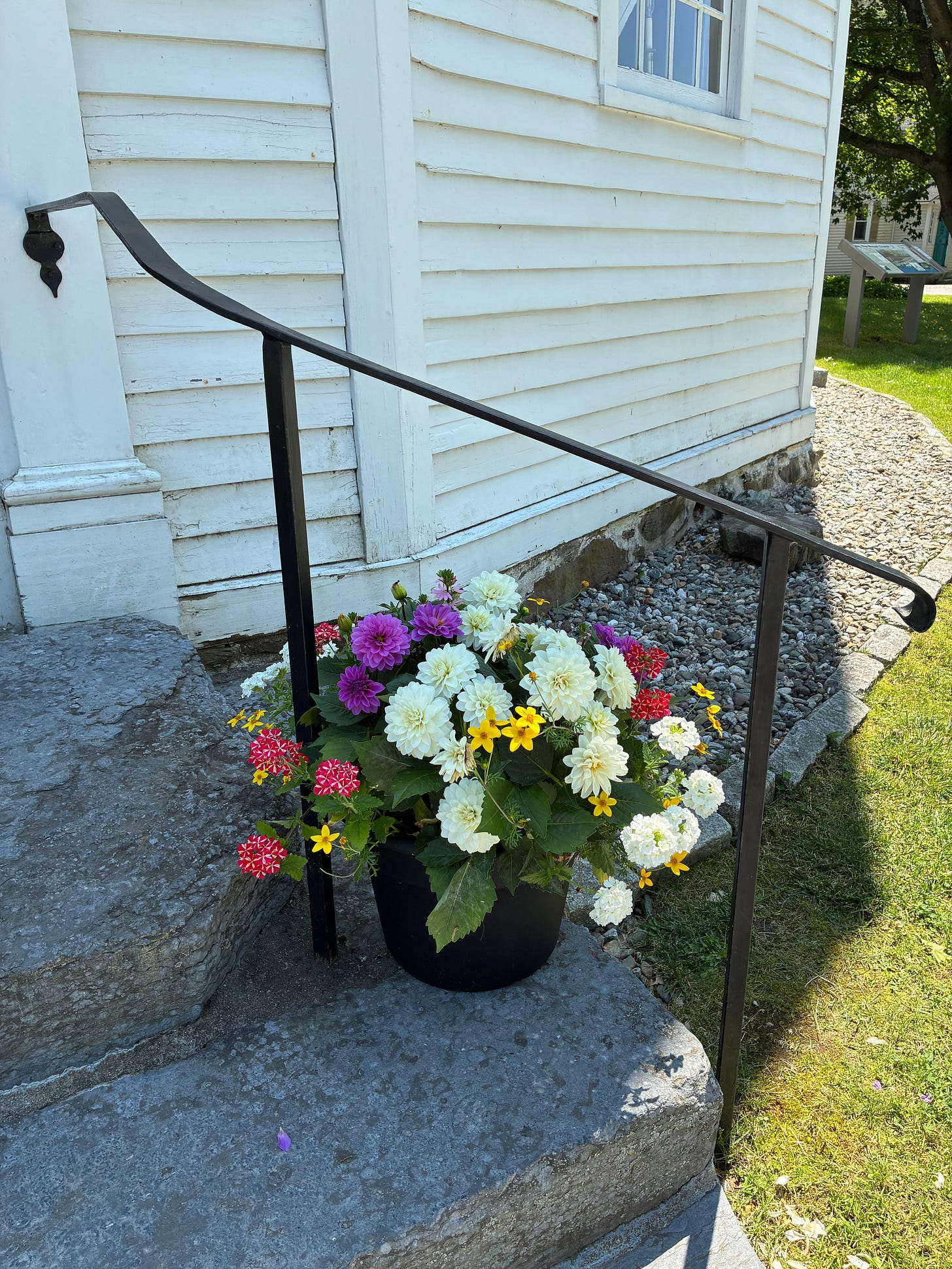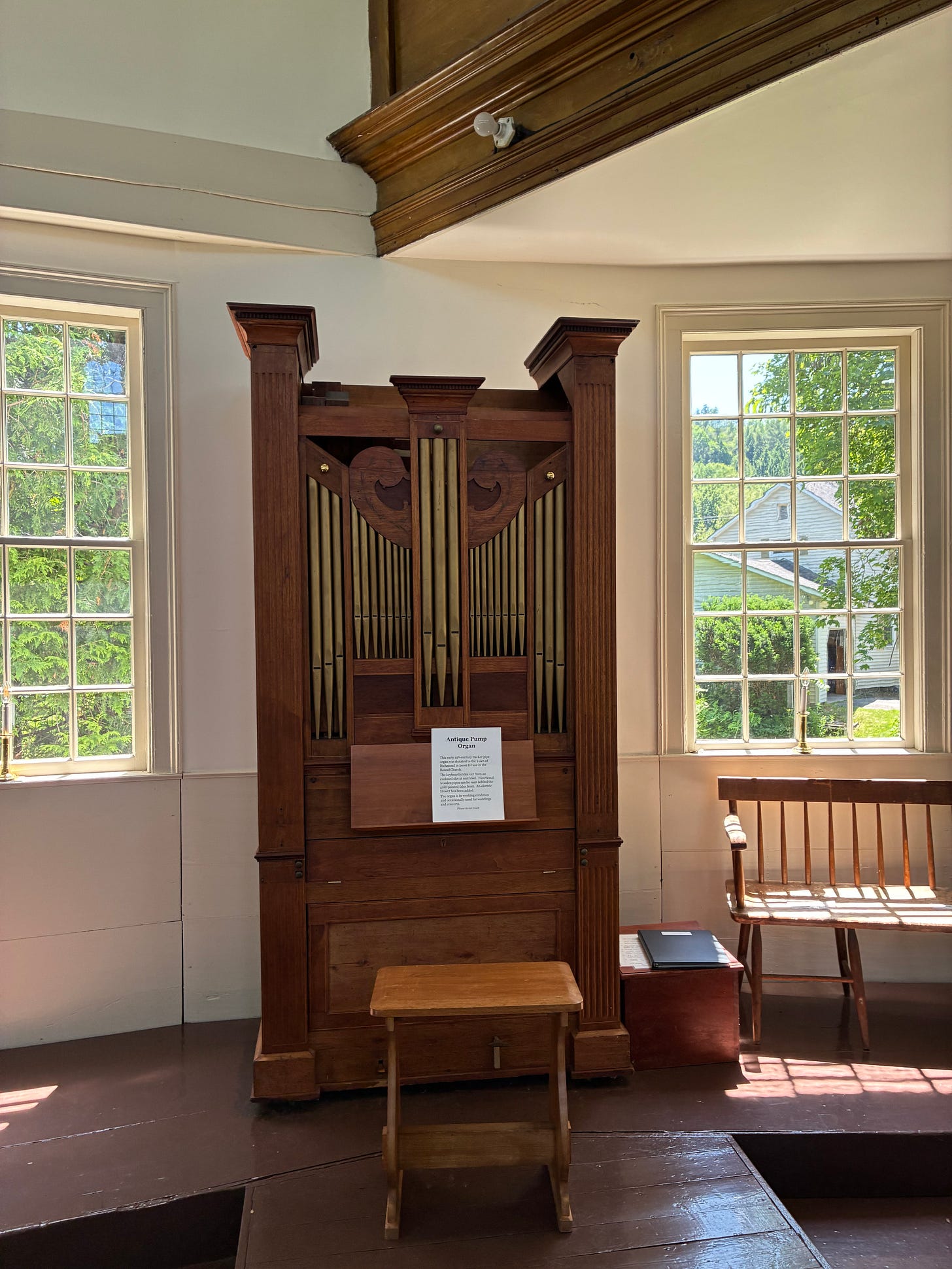Richmond (2/252)
a Vermont 251 post
This is an entry in my Vermont 251 Club series. The main post — which lists all 252 places in Vermont — is here. As I visit each one and write about it, the name will become a live link with a few days of the travelogue posting. The first one, telling the story of my adventure in Middlebury, is here.
Entries on South Burlington, Williston, Montpelier, Berlin, Huntington, Shelburne, and Glover are in various stages of completion, so if you think you would enjoy reading more of these, consider subscribing. Here’s a coupon.
I went to Richmond on June 21, which was during the halcyon period after round one of my tickborne illness, when I was feeling better but before round two started (and before I found the tick).
The Richmond Round Church is where I spent basically my entire Richmond visit. It’s one of the most humbling things a 2025 human can see — if you actually pause and think about it.
Built in 1812–1813 by a self-taught architect named William Rhodes.
Let that sink in.
No computer. No calculator. No AutoCAD. Not even a slide rule. The typewriter — the fucking typewriter — wouldn’t be invented for another 55 years.
If Rhodes needed to make a note, he dipped a feather in ink…and hoped the nib didn’t split.
I’m good at math. I’m good at art. And I genuinely doubt that I could have designed a round building from scratch using only the tools and books available in 1812. No YouTube tutorials. No Maxima. No Python math module. No ChatGPT.
Just me, a compass, some handmade graph paper (if I was lucky), and whatever formulas I could dredge up from first principles.
Maaaaaaybe I could pull it off with a month of undisturbed time, a cheering section, and more patience than I’ve demonstrated in my entire life combined.
But honestly? I doubt it. Especially if I also had to, you know, build it.
Seriously, how smart were Americans in 1812?
It’s easy to think of the past as full of simpler, less capable people — folks who churned butter and died of toothaches.
But standing in front of the Round Church forces a reevaluation of that smug, superior attitude. Because the building is elegant. Balanced. Weirdly modern in its symmetry. And it’s still standing more than two centuries later.
To really appreciate what you’re seeing in the photos, you have to remember what the world looked like when it was being built:
There were only 18 states in the Union. Vermont was basically still a frontier outpost.
The War of 1812 was happening. British troops would burn Washington, D.C. the year after the church was finished.
Photography didn’t exist. Not even in primitive form. If you wanted to remember what something looked like, you painted it.
Indoor plumbing? Still decades away. The people who built this church did not flush anything, even once.
Anesthesia hadn’t been invented yet. Surgery meant whiskey, a stick to bite down on, getting your closest male relatives to hold your legs and arms down, and begging the God of your understanding for mercy.
And somehow, in the middle of all that — with no formal training, no institutional support, no algorithmic assistance, no computers, no software, no code, no nothing — a guy named William Rhodes drafted and oversaw the construction of a 16-sided domed church that still stands today.
I took the pictures after driving there in a climate-controlled metal box on wheels that not only didn't need to be fed or watered, but responded instantly to my every whim — like changing the temperature, rerouting around traffic, or pausing a podcast so I could voice-text my friend
.Which I did.
Somewhere around Glover, I hit the microphone button on my touchscreen and said, “I know you’re filming; call me if you feel like it or if it would help during a break. Nothing’s wrong, I’m just visiting Richmond for my travel project.”
Josh, who was at home, using a condenser mic and a digital audio interface to record a multi-track conversation with someone whose physical body was time zones away.
Their audio files would sync to the cloud, get processed through noise-reduction software, and be edited with a click-and-drag interface that includes a tool literally called “um remover.”
That’s what I was doing while driving — asking about a multi-camera podcast recording done from a living room, edited on a laptop, and distributed globally within hours.
And then I pulled up to a building designed and raised by a man who had never seen a photograph.
Never flushed a toilet.
Never heard the word “microphone.”
Who drafted a geometrically complex, sixteen-sided, dome-capped church with a quill pen, scrap lumber, and maybe — maybe — a handmade protractor.
He made it with wood, nails, and brainpower.
If you’re not at least a little bit awestruck, check your pulse.
Sixteen Sides, No Straight Lines
The Round Church is almost unsettling in its elegance and beauty.
Not because it's strange, but because it's perfectly strange.
Sixteen sides, painted a clean, blinding white, arranged in a shape that feels improbable even as you’re standing inside of it.
Not quite round, not quite polygonal — just enough geometry to make my inner math nerd vibrate.
It’s like a word problem from the back of an honors geometry textbook came to life. I actually grinned, half-wondering if I’d fallen asleep at my desk and landed in some dreamscape designed by Euclid and God.
The wooden clapboards stretch around the curve like a hoop skirt — which, oddly enough, is exactly where my brain went. There's a passage in Little Town on the Prairie where Ma and Laura are sewing skirts for Mary to take to the Iowa college for the blind. They make them so hoops can be added once she gets there.
This building reminded me of that: practical beauty with space for grandeur.
Standing in the center, I was struck by a different kind of symmetry.
Not geometric. Existential.
Every breath I took in that room, surrounded by old pine and pews and silence, contained at least one atom exhaled by someone who stood there before me.
And not just someone.
But someone — maybe a farmer, or a bride, or a widower. Maybe a child who fidgeted through the sermon. Maybe a veteran from the War of 1812.
Maybe, statistically, an atom once exhaled by the Buddha. By Christ. By Laura Ingalls Wilder. By Ma.
It’s mathematically plausible.
But emotionally? It felt inevitable.
I think about this a lot: that every breath I take, mathematically, has at least one atom of Christ’s last.
The mathematics of breath is never more salient than when I’m walking into a very old place.
The rest of my day in Richmond, and more photos, after the paywall.
Keep reading with a 7-day free trial
Subscribe to Holly’s Substack to keep reading this post and get 7 days of free access to the full post archives.






